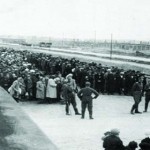By SAMANTHA MONTERREY, staff reporter
In 1944, Edith Eger and her family were taken from their home in Kassa, Hungary, and turned prisoners of Auschwitz, one of the largest, most notorious concentration camps of the Holocaust.
Eger, only 16 years old at the time, spent a gruesome year in Auschwitz.
“My parents were executed in the gas chambers shortly after we arrived at Auschwitz,” Eger said. “My sister Magda and I were the only survivors of my family.”
Eger, now a clinical Pyshcologist, will share her experiences with Central students on, May 15 at 4 p.m. in the Jerilyn S. McIntyre Music Building Concert Hall.
This is Eger’s first visit to Central, and she hopes that students will see her as a role model.
“I would like to show students how resilience and perseverance was with me throughout my time at Auschwitz,” Eger said. “A place where I discovered traumatizing things I never thought possible.”
Eger was an experienced ballerina and aspiring gymnast, prior to her imprisonment.
“I was preparing to compete in the upcoming Olympics when my family was taken to Auschwitz,” Eger said. “My dream was doing that.”
According to the United States Holocaust Memorial Museum, Dr. Josef Mengele was an infamous SS camp physician at Auschwitz and notorious for his inhumane experiments. Mengele soon found out about Eger’s dance history.
Upon her arrival to the camp, Mengele requested she entertain him with her dancing.
“I had to close my eyes and pretend I was dancing in an opera house in Hungary,” Eger said. “I could not bring myself to accept that I was dancing for the man that executed my family.”
According to Eger, it isn’t her experiences at Auschwitz that are important, but instead what they taught her.
“When you are in a situation like that you have to try to survive,” Eger said, “find the power within you as I did. You have to be a survivor and never a victim.”
Eger uses her history of survival to give hope to others suffering through traumatic circumstances.
“It’s not what’s happening, it’s what you do with it,” Eger said.
After a horrifying year, Eger was liberated in May 1945. She was found in a pit, surrounded by corpses, weighing only 60 pounds.
“I was left for dead, and I was rescued by an American soldier,” Eger said.
Auschwitz was one of the last concentration camps to be liberated before the war ended. Eger still holds onto the Red Cross documentation of when she was found.
After her liberation, Eger came across an ad for a concert featuring a violinist. The violinist was her older sister Klara, who Eger didn’t know was still alive.
“It was a very emotional experience,” Eger said. “She became my mother after that. She felt guilty that she wasn’t with me and my family in Auschwitz.”
Klara Eger had a long career as a violinist for the Sydney symphony in Australia and died in 2007 of Alzheimer’s disease.
Eger would like to dedicate some time for questions and encourages students to watch the DVD “Seeds of Resiliency,” which features Eger’s inspiring story and journey to survival.
Today, among other things, Eger is a renowned clinical psychologist and author. She works with victims of sexual assault, depression and post-traumatic stress disorder.
“When I am working with sexual abuse victims or even when I am speaking to students, I tell them, ‘don’t check out,’ I never did,” Eger said.
The only thing Eger held on to while at Auschwitz was her spirit. It was the one thing she felt they couldn’t take away.
“I never allowed the Nazis to murder my spirit,” Eger said. “They could beat and torture me but never ever take away my spirit.”
Heidi Szpek, philosophy and religious studies department chair and professor, believes Eger will bring a new perspective in the way she shares her story.
“I think no matter who you are, people go through a variety of horrific experiences, be it our veterans, be it survivors of genocide, be it individuals who have been abused,” Szpeck said. “They all need to find a way to move forward and I think that is the uniqueness. She wants to share her story and experiences, but it doesn’t end there – she wants to help others.”
Szpeck teaches Holocaust studies as part of the philosophy and religious studies department.
According to Szpeck, in her studies of the Holocaust she has read memoirs, historical documentations and books that describe the horrors and adverse conditions the prisoners of concentration camps faced.
“You learn about…the whole process of those who come to the camps,” Szpeck said. “The routine of those who were sent to Auschwitz, if not immediately sent to the gas chambers, who were allowed to live. You learn about the lack of food, the horrific conditions, the suffering endured, the forced labor under adverse conditions.”
What occurred in Auschwitz also occurred in other concentration camps.
According to Szpeck, recent research indicates that there were a total of approximately 42,500 camps established by the Nazis. Auschwitz, however, has become symbolic of the Holocaust.
“In a way, when we hear Auschwitz, it evokes understanding or memory of all these camps and it should also evoke memories of individuals who suffered in different camps and different situations,” Szpeck said.
Szpeck values the opportunity to listen to the story of a survivor.
“You can take a class on the Holocaust, you can read a book, and you can read memoirs – historical ones, personal ones,” Szpeck said. “You can listen to music composed in the camps. You can read poetry composed in the camps, but that is not the same as listening to the story of someone who was there.”
As a professor, Szpeck encourages her students to attend Eger’s visit, and as chair, she also encourages her faculty and staff to attend.
“It’s been 70 years – we start marking those specific dates connected with WWII and the Holocaust, and soon there will be no survivors to tell their stories,” Szpeck said. “As years pass by and we become further removed from events, we rely on historical written works, but there are those who won’t believe, those who need to hear it from someone who’s had these experiences.”
The Center for Diversity and Social Justice is sponsoring Eger’s visit, in honor of Jewish American Heritage Month, which is celebrated in the month of May.
Michelle Cyrus is a diversity officer for CDSJ. She hopes students will take advantage of this once-in-a-lifetime opportunity.
“How many times do you actually have the opportunity to talk to someone that has experienced something of that magnitude? It’s history,” Cyrus said. “You have living, breathing history at the moment.”








